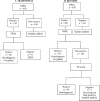Traditional versus reverse algorithm for diagnosis of syphilis - An Indian perspective from a national referral laboratory for sexually transmitted infections
- PMID: 40546351
- PMCID: PMC12180856
- DOI: 10.4103/ijstd.ijstd_132_24
Traditional versus reverse algorithm for diagnosis of syphilis - An Indian perspective from a national referral laboratory for sexually transmitted infections
Abstract
Background: Syphilis diagnosis can be confirmed by two testing algorithms. In the traditional algorithm, a nontreponemal test is used as a screening test to rule out syphilis which, if reactive, is confirmed by a treponemal test. In the reverse algorithm, a treponemal test is used as a screening test, which, if positive, is confirmed by a nontreponemal test. If the nontreponemal is negative, a second treponemal assay of a different principle is performed to resolve the discordant result. The aim of this study was to compare the traditional and reverse algorithms for the diagnosis of syphilis in a National Referral Apex Centre for Sexually Transmitted Infections.
Materials and methods: A retrospective study was done on samples received from male and female sexually transmitted infection clinics for syphilis testing. All samples were tested simultaneously using the Venereal Disease Research Laboratory (VDRL), Treponema pallidum hemagglutination assay (TPHA), and fluorescent treponemal antibody absorption (FTA-Abs) test. The results of syphilis serological testing were interpreted using the traditional and reverse algorithms. The traditional algorithm used VDRL as the screening test and TPHA as the confirmatory test. In the reverse algorithm, TPHA was the screening test, and reactive results were confirmed with VDRL. Discordant samples were confirmed with the FTA-Abs test.
Results: The reverse algorithm showed a significantly higher seroprevalence of syphilis than the traditional algorithm (62.4% vs. 40.8%, P < 0.0001). The traditional algorithm had a high missed serodiagnosis rate (34.6%) and showed a higher false-positive rate of the screening test (6.8%) as compared to the reverse algorithm (0.6%).
Conclusions: This study supports the use of reverse algorithms for diagnosing syphilis in high-prevalence populations.
Keywords: Reverse algorithm; Treponema pallidum hemagglutination assay; Venereal Disease Research Laboratory; syphilis screening algorithm; syphilis serodiagnosis.
Copyright: © 2025 Indian Journal of Sexually Transmitted Diseases and AIDS.
Conflict of interest statement
There are no conflicts of interest.
Figures
Similar articles
-
Diagnostic Properties of Different Serological Methods for Syphilis Testing in Brazil.Diagnostics (Basel). 2025 Jun 6;15(12):1448. doi: 10.3390/diagnostics15121448. Diagnostics (Basel). 2025. PMID: 40564770 Free PMC article.
-
A retrospective study to assess the accuracy of syphilis rapid test by chemiluminescent microparticle immunoassay (CIA) in volunteer blood donors.Indian J Sex Transm Dis AIDS. 2025 Jan-Jun;46(1):22-24. doi: 10.4103/ijstd.ijstd_115_24. Epub 2025 Jun 9. Indian J Sex Transm Dis AIDS. 2025. PMID: 40546366 Free PMC article.
-
Signs and symptoms to determine if a patient presenting in primary care or hospital outpatient settings has COVID-19.Cochrane Database Syst Rev. 2022 May 20;5(5):CD013665. doi: 10.1002/14651858.CD013665.pub3. Cochrane Database Syst Rev. 2022. PMID: 35593186 Free PMC article.
-
Rapid, point-of-care antigen tests for diagnosis of SARS-CoV-2 infection.Cochrane Database Syst Rev. 2022 Jul 22;7(7):CD013705. doi: 10.1002/14651858.CD013705.pub3. Cochrane Database Syst Rev. 2022. PMID: 35866452 Free PMC article.
-
Population-based interventions for reducing sexually transmitted infections, including HIV infection.Cochrane Database Syst Rev. 2004;(2):CD001220. doi: 10.1002/14651858.CD001220.pub2. Cochrane Database Syst Rev. 2004. Update in: Cochrane Database Syst Rev. 2011 Mar 16;(3):CD001220. doi: 10.1002/14651858.CD001220.pub3. PMID: 15106156 Updated.
References
LinkOut - more resources
Full Text Sources
Miscellaneous



